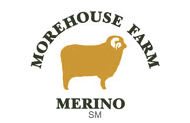About The Wool
The first American superfine imports
In 1987 we imported the first two superfine Merino rams from Australia into America. Superfine Merino are bred in Australia and New Zealand for their superior fine wool.
Now our breeding program involved testing and re-testing of our wool for fineness to make sure that our stud rams were producing high-quality progeny. Not only fineness of wool mattered to us, we wanted our fleeces to be brilliantly white, dense and long stapled.
MEET THE SHEEP!

From fleece to knitting yarn
Step 1: shearing and sorting the wool
Once a year the sheep are shorn. A crew of professional shearers is hired to do the work. Shearing a Merino sheep is a job for a skilled professional, because hidden underneath a year’s growth of wool are skin folds and wrinkles and care must be taken not to cut the sheep. It will take them 2 to 3 days to shear the entire flock. Then the shorn wool, called fleece, is sorted by color and by quality. Using a mechanical wool baler, each lot is compressed into separate bales. The final bales will be the size of a kitchen table but will weigh as much as three hundred pounds.
Step 2: washing the wool
Then the wool is trucked to a scouring facility for washing and cleaning (scouring is the technical term for the wool washing process). The wool is washed in large vats using very hot water and soap.
One of the by-products of this washing process is lanolin. Before washing, the wool feels greasy and sticky. That grease in the wool is called lanolin. It is a natural lubricant produced by the sheep’s glands to protect the wool and to keep the skin smooth and supple. This grease will be extracted from the washing water, then later purified and used as base in cosmetics, creams and lotions.


There is another way to clean wool: it’s called carbonizing. Carbonizing is a process where wool is put through a mild acid bath to dissolve vegetative matter. Because carbonizing harshens wool slightly—it affects the the way the wool feels—it would become necessary to add artificial softener later to correct the damage.
At Morehouse Farm, we never carbonize our wool. We prefer to wash our wool to keep the natural softness intact. You may find small pieces of straw and hay embedded in our wool—we call them (jokingly, of course) the Morehouse Merino Mark of Authenticity. But you can feel good about it knowing that the wool you are knitting with or that you are wearing is pure, naturally soft Merino wool.
Step 3: carding and spinning the wool
Then the washed wool is brought to a spinning mill, where it is carded and spun into yarn. On the carding machine, the wool passes through rollers covered with tiny wire spikes that untangle and straighten the fibers. The carded fibers are then divided into narrow strips called pencil roving, ready for spinning. And on the spinning frame the narrow strips are finally twisted into yarn.
We’ve experimented for many years to get the right amount of twist in the yarn, and blending black and white wools to produce pleasing natural colors. We plied (twisted together) different weights of our yarn for unique new looks and yarns. Some of our yarn has more twist for a smoother feel and look (shows off knitting stitches to their best advantage); other yarns have very little twist for that ultra soft feel and exceptional warmth, and lately we have been busy spinning yarn thick and thicker to meet the growing demand for bulky and chunky knitting yarn.


Step 4: to dye or not to dye
For the first ten years of our operation, we never considered dyeing our Merino yarn. Our natural colors were colorful enough and we never tired knitting with them. That all changed, however, when we started attending the Greenmarkets in New York City in the 1990’s. Imagine displaying our yarn next to fruit and vegetable stands. Our natural colors seemed drab compared to bright red strawberries, golden apples and fresh green vegetables. We had to compete—quite literally—with the tomatoes! So we started dyeing some of our Merino yarn bright colors. And we have been doing it ever since (at a dye plant in North Carolina). While we are no longer at the Greenmarkets, we’ve continued dyeing our yarn in over 60 sumptuous colors.
 | 100% GROWN & SPUN IN AMERICA
| 100% GROWN & SPUN IN AMERICA 
